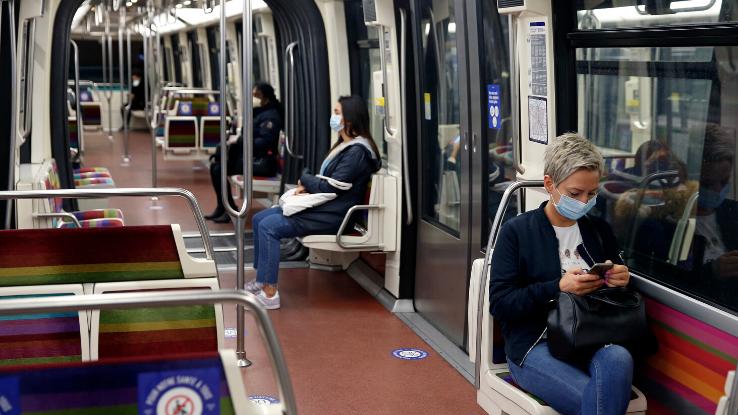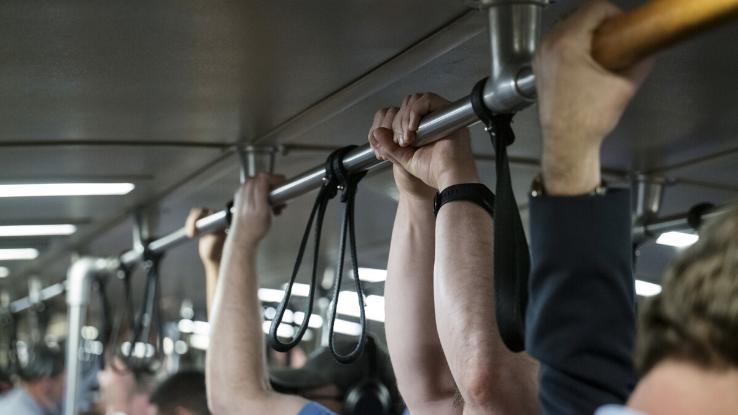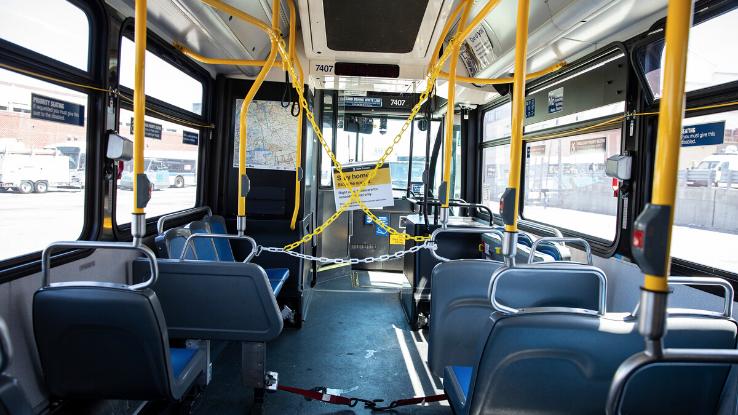Which Of The Following Will Result In A Chemical Change

Since March 2020, many commuters in the United States started working from home — so long as their jobs immune for remote work. And, in the wake of this shift, nosotros've all seen the commentary on social media: in California, for example, Los Angeles' notorious traffic congestion became nonexistent at 1 betoken — and, with fewer cars and buses bottleneck streets, even the air felt cleaner. In fact, at that place's been "a remarkable worldwide reduction in ambient air pollution" with particulate affair concentrations in L.A. decreasing by 25–30% as compared to the same month a year ago (via The Lancet).
With the COVID-19 vaccine rollout well underway, offices accept started issuing reopening plans, which means folks who aren't essential workers will likely start commuting more regularly in the very near futurity. For many, "reentering" society or getting back to things they used to do can be unnerving. For instance, once-packed subway trains and buses don't seem all too enticing, no matter 1's vaccination status. Do you really want to squeeze onto a crowded train platform or be stuck in a metal cylinder for 45 minutes with folks who may or may not be wearing masks?
For some, public transit is the only option when information technology comes to commuting, running errands, and accessing resource. However, for those with the privilege and means, driving might hold more than appeal, but that pick could conductor in a whole host of problems, from the return of gridlocked highways and emissions to higher gas prices. It's as well no secret that nether-funded public transportation agencies across the state accept been struggling — and the subject of President Joe Biden'south latest improvement project. So, what have we learned from the pandemic — and how will those lessons inform our arroyo to taking, building, and maintaining public transit?
As Cities Reopen, Commuters Return to the Streets
Confined infinite, shut proximity to others and seats, bars and buttons that you and thousands of other commuters touch daily. Those are the things of public transportation. And none of them feel especially safe in a mail service-COVID-nineteen world. Of form, some riders who can't afford a machine, don't have access to one or who work in an area that makes driving impractical take no choice but to rely on public transit. Even now — and throughout the pandemic — essential workers have taken buses and trains daily.

Right now, though, it's hard to determine whether or not how many of those commuters with a choice will opt for personal cars over trains. In the San Francisco Bay Expanse, where revised shelter-in-place orders accept allowed some businesses to reopen, more than and more folks accept begun commuting and crossing the state-owned bridges. Only even after reopening began, The Mercury News reported that traffic on the Bay Area's bridges was still forty% beneath normal. Meanwhile, commuters who have the Bay Area Rapid Transit, or BART commuter trains, accept climbed a smidge higher, though they nonetheless haven't returned to pre-COVID-19 levels.
However, in the Bay Area, just 20% of commuters accept public transit or carpool, then maybe San Francisco isn't the best city by which to mensurate how bad the traffic will become. For that affair, neither is L.A. — though we can imagine both California cities turning into an even messier gridlock than usual. Like other public services and spaces, the San Francisco Municipal Transportation Agency (SFMTA) is now requiring passengers to wear confront coverings while on trains and buses and asking folks to practice social distancing when it comes to selecting a seat or place to stand. In fact, the SFMTA website is even encouraging San Franciscans to try out modes of rentable transit JUMP Bikes or Lime scooters, which allow for personal space.
In pre-pandemic New York Metropolis, over viii,000 subway train trips occurred daily, carting nearly 6 million New Yorkers from home to work and back again. According to the New York Daily News, subway ridership fell by a whopping 93% in April, though the Metropolitan Transit Authority (MTA) predicts that number will transform into a 60% decrease by the fall — still a significant drop, but, on the other hand, that's a lot of commuters sharing a tight space.

"Customers' awareness of and appointment with their ain safety will exist central [to reopening]," said acting NYC Transit President Sarah Feinberg. "Anybody in the system will take a role to play in keeping our metropolis healthy." While being aware and mindful of i's own wellness and limitations is of import, that statement doesn't really put ane's mind at ease. Many New Yorkers rely on the subway and bus systems to accomplish jobs that are many neighborhoods — and sometimes rivers or boroughs — abroad from their homes.
Moreover, considering subway trains became relatively empty, New Yorkers who are experiencing homelessness have used subway cars equally places of refuge, especially during the pandemic when social distancing has been nigh-impossible to maintain in shelters. "They should be offer everyone on the street access to a hotel room. They aren't doing that. That'due south the main trouble," Giselle Routhier, policy director for the Coalition for the Homeless, told the NY Daily News. "People don't feel safe [in shelters]."
For at present, the MTA has hired private contractors to boost subway and bus cleanliness. Co-ordinate to the bureau, those contractors work to disinfect subway cars and buses every 72 hours, while workers aim to make clean station surfaces several times throughout the day. Every bit is the case in other major cities, passengers must wear face coverings on public transit. As the city's reopening continues, many New Yorkers are difficult-pressed to find alternatives.
While the metropolis's infamous yellow cabs take protective barriers between passengers and drivers, the cars tin't be cleaned thoroughly between each ride. Lyft and Uber, meanwhile, have mandated that all passengers vesture face coverings, sit in the back seats of the cars and, when possible, roll down windows to promote air flow. Needless to say, even rideshares — the credible future of transit — aren't adequately prepared to address the health concerns of a post-COVID-19 world. All of this is to say that the future of public transit is bound to change drastically, merely we'll have to wait and meet just how transportation agencies plan to accomplish this.
Source: https://www.reference.com/world-view/life-after-covid19-public-transit-changes?utm_content=params%3Ao%3D740005%26ad%3DdirN%26qo%3DserpIndex
Posted by: billswiclactustob.blogspot.com


0 Response to "Which Of The Following Will Result In A Chemical Change"
Post a Comment